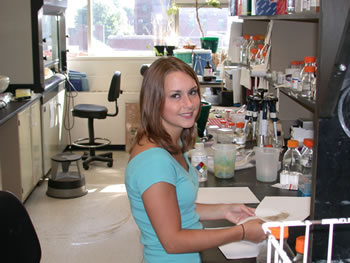Research Experiences for Undergraduates (REU) Program
(University of Connecticut)
Melina Chasse |
Melina Chasse is aiding the cell wall genomics project by helping us to create double mutants with known cell wall defects. This is very important since it will help us to understand and interpret the FTIR spectra of cell walls obtained from unknown mutants. Specifically she is working to create a mutant with no fucose in its cell wall. To do this she needed to create a double mutant plant that was defective in the GMD1 and GMD2 genes that make fucose available for incorporation into the cell wall. Last year she discovered that F1 progeny from the dihybrid cross have to be grown on media supplemented with fucose to produce the double mutant. This is apparently the result of a defect in the cell walls of pollen tubes. Interestingly, the only phenotypic difference between gmd2 plants and a gmd1/gmd2 double mutant is male sterility when grown in the absence of fucose. Melina is now characterizing the defect in pollen growth that leads to male sterility. In addition she is attempting to create a second version of this double mutant where she can be more confident that the genes are entirely nonfunctional. This is because in the original cross that she did one of the mutants (gmd2) carried a missense mutation. While there is no detectible enzymatic activity, it is still possible that the encoded protein functions at a low level. Melina has now crossed a SALK line, where the gmd2 gene is interrupted by a large transfer DNA (T-DNA) to gmd1 and is screening the F2 progeny for a double mutant. So far she has not found a double mutant where both the gmd1 and gmd2 genes are disrupted by T-DNA insertions. It is not yet clear if it is not possible to get this mutant (i.e some fucose is required in the cell wall), or if she simply needs to screen more progeny. This should become clear in the coming weeks. Melina is very interested in discovering if this double mutant has a visible phenotype. |
|
Back to top

